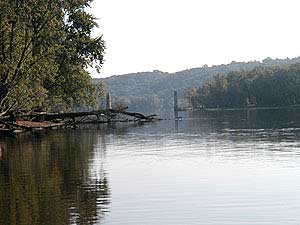|
Audio
Photos
More from MPR
Resources
|
 |
| More segments of the St. Croix River have been added to the MPCA's impaired waters list. (MPR file photo) |
St. Paul, Minn. — Federal law requires the state to update it's list of impaired waters every two years. This year the impaired waters list grew to more than 2,200.
In Minnesota, only 14 percent of lakes and 8 percent of rivers have been assessed. MPCA Assistant Commission Lisa Thorvig says the list will grow much longer in coming years.
"Right now where we assess our waters, about 40 percent are impaired and about 60 percent are meeting water quality standards," Thorvig says. "If we just extrapolate that out to all of our waters, we expect we will reach about 10,000 water impairments being listed once we've fully assessed our waters."
At the present rate, it could take decades just to assess the pollution in Minnesota lakes and rivers.
|
There are dozens of water bodies with so much bacteria they're dangerous to swim in. In other cases, pollution makes it dangerous to eat more than one fish a month taken from the water.
|
A lake or a stretch of river can get on the impaired list for a variety of reasons.
Nearly two-thirds of water impairments relate to fish consumption advisories because of high levels of mercury. The water may also have too much dangerous bacteria, too much sediment, or too much phosphorus.
There are dozens of water bodies with so much bacteria they're dangerous to swim in. In other cases, pollution makes it dangerous to eat more than one fish a month taken from the water.
Whatever the reason, impairment means those waters don't meet standards for public use under the federal Clean Water Act. That limits recreational uses like swimming or fishing.
Thorvig says a lack of funding continues to limit the agency's work on polluted waters.
"We've been talking to the Legislature about the need to fund an initiative to fund impaired waters, so this is just another piece that heightens the need for us to get something in place to address Minnesota's impaired waters," says Thorvig.
The MPCA says it will cost hundreds of millions of dollars to identify and restore polluted lakes and rivers in Minnesota.
Kris Sigford with the Minnesota Center for Environmental Advocacy says the growing list of polluted waters should ring alarm bells for Minnesotans. Sigford says the state isn't spending enough to test water, develop plans to protect it, or restore polluted waters.
"The most expensive part of the whole program will be restoration, bringing these waters back around to where they support safe recreation for people, and safety in consuming fish, and so forth," says Sigford. "It's going to take a sustained effort, and I certainly hope this adds to the pressure on the Legislature and the governor to enact Clean Water Legacy."
Clean Water Legacy is a legislative proposal to raise $80 million a year for the next 10 years, to assess and clean up polluted lakes and rivers. Lawmakers have rejected the plan several times.
A court case earlier this year may be just the beginning of legal wrangling over Minnesota water. A judge ruled new urban development could be limited if it affects an already polluted waterway.
MPCA Assistant Commissioner Lisa Thorvig says the state needs to pick up the pace of water monitoring and cleanup. If it doesn't, she says, there will likely be more lawsuits attempting to force the state into compliance with federal clean water standards.



